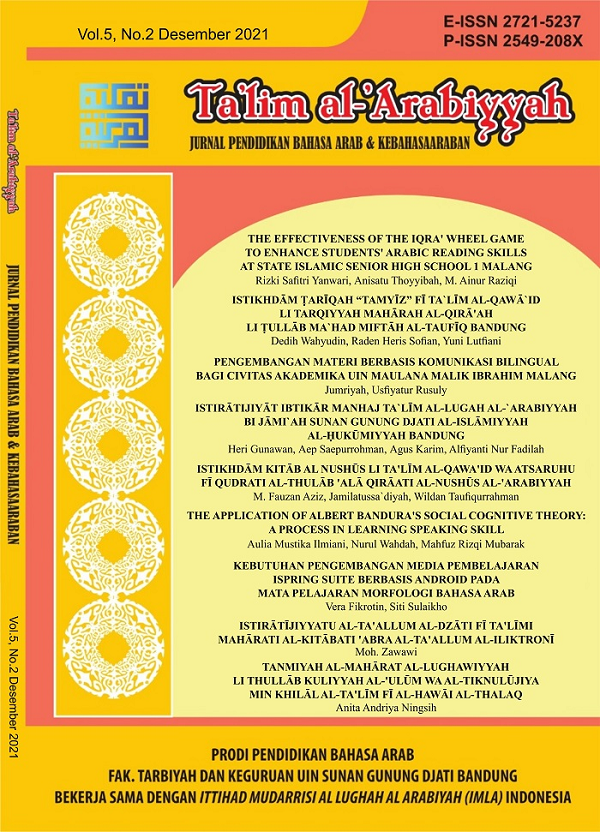The Effectiveness Of The Iqra’ Wheel Game To Enhance Students’ Arabic Reading Skills At State Islamic Senior High School 1 Malang
DOI:
https://doi.org/10.15575/jpba.v5i2.14476Abstract
Learning media appears to be a pivotal need for learning programs used to reach out learning objectives. This study aims to find out the application and effectiveness of the Iqra' wheel game to enhance students' Arabic reading skills. This study uses a quantitative approach with the type of experiment. The subjects used are language students of tenth grade and 2nd MIPA students of tenth grade with a sample 60 students. Methods used observation, interviews, questionnaires, tests, and documentation. Data analysis techniques used in research is validity test, reliability test, sample t-test and effectiveness test. The research findings showed that is a significant difference between the pre-test and post-test scores. The pre-test score is quite smaller the post-test score of 84.41 < 90.58. The percentage of N-Gain shows 38.23% with a quite effective category. It can be concluded that the iqra wheel game is “quite effective†in improving Arabic reading skills.References
Adhikari, R., Kydonaki, J., Lawrie. (2021). A Mixed-Methods Feasibility Study to Assess the Acceptability And Applicability Of Immersive Virtual Reality Sepsis Game As An Adjunct To Nursing Education. Nurse Education Today, 103(1), 1-11. https://doi.org/ 10.1016/j.nedt.2021.104944
Al-Basheer, A., Ashraah, M., Alsmadi, R. (2015). Arabic Language Teachers and Islamic Education Teachers' Awareness of Authentic Assessment In Jordan. Teacher Development, 19(4), 483-496. https://doi.org/10.1080/13664530.2015.1064824
Baroroh, R., Mardliyyah, A. (2019). Development of the Ladder Snake Game Media in Arabic Learning/ Pengembangan Media Permainan Ular Tangga Dalam Pembelajaran Bahasa Arab. Ijaz Arabi Journal of Arabic Learning, 2(1), 64-76. https://doi.org/10.18860/ijazarabi.v2i1.5445
Fahrurrozi, A. (2014). Pembelajaran Bahasa Arab Problematika Dan Solusinya. ARABIYAT Jurnal Pendidikan Bahasa Arab dan Kebahasaaraban, 1(2), 162-179. https://doi.org/ 10.15408/a.v1i2.1137
Hamzah, Utami., S U, Zulkarnain. (2019). Pengembangan Media Pembelajaran Roda Putar Fisika untuk Meningkatkan Motivasi Belajar Siswa. Jurnal Hasil Kajian, Inovasi, dan Aplikasi Pendidikan Fisika, 5(2), 77-80. https://doi.org/10.31764/orbita.v5i2.1192
Hermawan, H. (2019). Riset Hospitalitas Metode Kuantitatif untuk Riset Bidang Kepariwisataan. Yogyakarta: Open Scince Framework.
Ignacio, J., Chen, H. (2020). The Use of Web-Based Classroom Gaming to Facilitate Cognitive Integration In Undergraduate Nursing Students: A Mixed Methods Study. Nurse Education in Practice, 46, 102820. https://doi.org/10.1016/j.nepr.2020.102820
Irdawati, Yunidar, dan Darmawan. (2017). Meningkatkan Kemampuan Membaca Permulaan Dengan Menggunakan Media Gambar Kelas 1 di Min Buol. urnal Kreatif Tadulako Online, 4(5), 1-14. http://jurnal.untad.ac.id/jurnal/index.php/JKTO/article/view/2918
Lutfiyatun, E. (2015). Pengembangan Media Game Edukasi Berbasis Adobe Flash CS5 pada Keterampilan Menulis Bahasa Arab Untuk Siswa Kelas VIII MTs. Skripsi. Semarang: Universitas Negeri Surabaya. Tidak Diterbitkan.
Mancheva., L., Reichle, E., Lemaire, B. (2015). An Analysis of Reading Skill Development Using E-Z Reader. Journal of Cognitive Psychology, 27(5), 657-676. https://doi.org/10.1080/20445911.2015.1024255
Muna, W. (2014). Kartu Permainan: Media Pembelajaran Bahasa Arab Kontekstual. Jurnal Al-Ta'dib, 7(1), 4-100. https://doi.org/10.31332/atdb.v7i1.245
Muradi, A., (2013). Tujuan Pembelajaran Bahasa Asing (Arab) Di Indonesia. Al-Maqoyis, 2(1), 128-136. https://doi.org/ 10.30997/tjpba.v1i2.3091
Murda, N., Purwanti, P. (2017). Penerapan Strategi Pembelajaran Think Pair Share untuk Meningkatkan Kemampuan Membaca Intensif Siswa. International Journal of Elementary Education, 1(1), 11-18. https://doi.org/10.23887/ijee.v1i1.11434
Priyatni, E. (2014). Pengembangan Bahan Ajar Membaca Kritis Berbasis Intervensi Responsif. Jurnal Litera, 13(1), 1-13. https://doi.org/10.21831/ltr.v13i1.1900
Sumantri, M., Sudana, D., Adnyana, I. (2017). Penerapan Media Gambar Dan Kartu Huruf Untuk Meningkatkan Keterampilan Membaca Permulaan. International Journal of Elementary Education, 1(1), 1-10. https://doi.org/ 10.23887/ijee.v1i1.11433
Verhoeven, L., Pefetti, C. (2011). Introduction To This Special Issue: Vocabulary Growth and Reading Skill. Scientific Studies of Reading, 15(1), 1-7. https://doi.org/ 10.1080/10888438.2011.536124
Whitton, N., Maclure, M. (2017). Video Game Discourses and Implications for Game- Based Education. Discourse, 38(4), 561-572. https://doi.org/10.1080/01596306.2015.1123222
Zedan, A., Kadir, F., Yusof, M. (2013). The Role of Language in Education: Arabic as Case Study. Procedia - Social and Behavioral Sciences, 70, 1002-1008. https://doi.org/ 10.1016/j.sbspro.2013.01.151
Downloads
Published
How to Cite
Issue
Section
License
Authors who publish in Ta'lim al-'Arabiyyah: Jurnal Pendidikan Bahasa Arab dan Kebahasaaraban agree to the following terms:
- Authors retain copyright and grant the journal right of first publication with the work simultaneously licensed under a Creative Commons Attribution-ShareAlike 4.0 International (CC BY-SA 4.0) License that allows others to share the work with an acknowledgment of the work's authorship and initial publication in this journal.
- Authors are able to enter into separate, additional contractual arrangements for the non-exclusive distribution of the journal's published version of the work (e.g., post it to an institutional repository or publish it in a book), with an acknowledgment of its initial publication in this journal.
- Authors are permitted and encouraged to post their work online (e.g., in institutional repositories or on their website) prior to and during the submission process, as it can lead to productive exchanges, as well as earlier and greater citation of published work (See The Effect of Open Access).
![]()
Ta'lim al-'Arabiyyah: Jurnal Pendidikan Bahasa Arab dan Kebahasaaraban is licensed under a Creative Commons Attribution-ShareAlike 4.0 International License.
Based on a work at https://journal.uinsgd.ac.id/index.php/Talim







